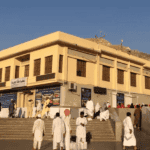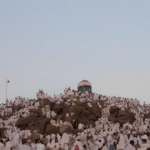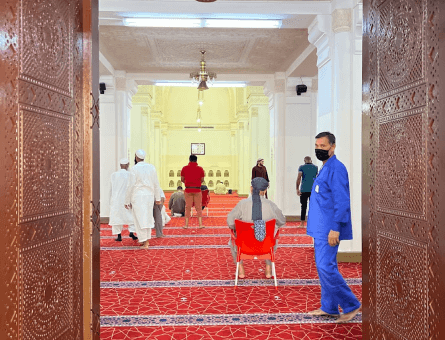Mataf – Meaning, Capacity & Role in Hajj at Masjid al Haram
The Mataf is the unique open area surrounding the Kaaba in Masjid al Haram where people walk around the Kaaba seven times as part of the ritual called tawaf. This spot feels alive with history and devotion, drawing millions who follow this age-old tradition. Knowing the Mataf helps visitors grasp the heart of these spiritual journeys, offering a glimpse into practices that have stayed strong for centuries. Keep reading to unlock the secrets of this sacred space and what makes this act so powerful for those who visit.
This ritual is a key part of both the Hajj and Umrah pilgrimages. As the number of pilgrims has grown, the Mataf has been expanded and improved to ensure everyone can worship safely and peacefully.
It remains the spiritual center of Makkah and a symbol of unity for Muslims worldwide.
What is Mataf in Islam?
In Islam, the Mataf is the area around the Kaaba where pilgrims perform tawaf by circling it seven times, starting at the Mataf green light. This ritual is central to both Hajj and Umrah.
Once a simple stone space, the Mataf is now built to handle millions, with a slip-resistant surface and heat control.
It reflects the footsteps of Prophet Ibrahim (عليه السلام) and Prophet Muhammad (صَلَّى ٱللَّهُ عَلَيْهِ وَسَلَّمَ), making it a deeply spiritual space.
What is the Mataf capacity?
The Mataf now holds up to 107,000 pilgrims per hour thanks to modern upgrades. This includes multiple levels and the Mataf ring for wheelchair users.
During peak Hajj days, innovative design, crowd control, and safety systems help manage the flow, allowing pilgrims to perform tawaf smoothly and safely.
Mataf now holds up to 107,000 pilgrims per hour
References in the Holy Quran
The act of tawaf performed in the Mataf area is deeply rooted in the Qur’an.
This verse shows the sacredness of the Mataf as the space for worship around the Kaaba, emphasized by Prophet Muhammad (صَلَّى ٱللَّهُ عَلَيْهِ وَسَلَّمَ).
What does the word “Mataf” mean?
The word “Mataf” comes from the Arabic root ط-و-ف, meaning to circle. It refers to the area around the Kaaba where pilgrims perform tawaf—the term links directly to the ritual, showing how language and worship are connected in Islam.
Map of Mataf
The Mataf is a circular area around the Kaaba with ground-level and elevated floors to manage crowd flow.
The Masjid Haram lies to the north, and the outer ring leads to Sa’i between Safa and Marwa.
One full round is about 145 meters, so seven rounds total nearly 1 kilometre. Knowing this layout helps pilgrims focus on worship.
One full round is about 145 meters
How the Mataf Flooring Has Evolved for Pilgrims
The Mataf flooring used to be stone or dirt. Today, it is made of smooth marble that stays cool and prevents slipping.
This helps pilgrims walk safely, even during hot weather or crowded days. The floor is cleaned often and is built to handle millions of people during Hajj and Umrah.
Comparison Between Masjid Al Aqsa and Masjid Al Haram’s Mataf
Masjid Al Aqsa is a sacred mosque in Jerusalem, but does not have a Mataf.
Only Masjid al Haram in Makkah has a Mataf area for tawaf, which makes it special for the Hajj and Umrah.
Images of Mataf
Images of Mataf show a powerful view of devotion and unity. In the centre stands the Kaaba, surrounded by thousands moving in harmony.
You can see elderly pilgrims in wheelchairs, families with children, and worshippers of every background moving shoulder to shoulder.
These images also highlight the Mataf area during various day phases — sunrise, midday heat, and calm nights.
Photos also capture the Mataf ring, a dedicated elevated path built to accommodate disabled pilgrims. High-resolution aerial shots taken during peak season show how dense and orderly the crowd becomes, making the circular pattern almost like a spiritual whirlpool.
The What is mataf in haram image search result often returns some of the most breathtaking photos of Hajj.
Role of the Grand Mosque in Organizing Tawaf Around the Mataf
Masjid al Haram, the Grand Mosque, helps manage the flow of people in the Mataf area. It has wide entrances, clear signs, and trained staff to guide pilgrims.
These systems keep the tawaf moving
Mataf development over the years
The development of the Mataf has gone through many phases — from a bare sandy courtyard to a multi-level architectural marvel. Let’s explore this evolution in depth.
What Is the Significance of Maqam and Mataf Near the Kaaba?
Maqam Ibrahim is a small stone near the Kaaba inside the Mataf. It shows the place where Prophet Ibrahim (عليه السلام) stood while building the Kaaba. Pilgrims pray near it after completing tawaf, as taught by Prophet Muhammad (صَلَّى ٱللَّهُ عَلَيْهِ وَسَلَّمَ).
Early years – open and unstructured
In the time of the Prophet Muhammad (صَلَّى ٱللَّهُ عَلَيْهِ وَسَلَّمَ), the Mataf was an open area paved with stone. It was wide enough to allow people to complete the tawaf, but no official safety measures or flooring existed. The number of pilgrims was small, and most of the surrounding area was undeveloped.
Ottoman period – paving and shade
During the Ottoman era, enhancements included paving the Mataf with smooth stones and installing shaded areas for comfort.
Although still basic, it introduced some planning and structure. Marble was introduced to reflect sunlight and reduce heat buildup.
20th century – expansion begins
In the 1960s and 1970s, Saudi Arabia initiated structured expansions. The floor was enlarged, and more entrances were added.
Infrastructure planning began for water distribution, lighting, and dedicated exits for efficient pilgrim flow.
2000s – multi-level upgrades
In the early 2000s, upper-level Mataf tracks connected by ramps and elevators were introduced.
This was in response to a sharp increase in pilgrims and the need to avoid ground-level overcrowding.
The Mataf ring – innovation for accessibility
A significant feature of the modern era is the Mataf ring. This elevated circular walkway allowed those in wheelchairs or with mobility challenges to perform tawaf safely.
The ring offers a direct view of the Kaaba, ensuring all pilgrims enjoy the spiritual closeness of the ritual.
Smart crowd management
Recent improvements include facial recognition cameras, smart gates, and AI-based crowd flow models.
These ensure that the Mataf capacity is never exceeded and that emergency response is instant if needed.
Future planning
Ongoing projects continue under the broader umbrella of the Mataf expansion project. Plans include increasing shade coverage, air cooling systems, and real-time crowd density feedback for organisers. All upgrades preserve the sanctity of the ritual while improving safety and ease for future generations.
FAQ
Summary – Mataf
The Mataf in Masjid al-Haram is the heart of the pilgrimage, where Muslims perform tawaf around the Kaaba.
The current Mataf connects pilgrims to the legacy of Prophet Ibrahim (عليه السلام) and Prophet Muhammad (صَلَّى ٱللَّهُ عَلَيْهِ وَسَلَّمَ).
Thanks to the Mataf expansion project, this sacred space will support millions during Hajj 2025.
Whether standing at the Mataf green light or walking the Mataf area, pilgrims experience unity, devotion, and submission to Allah (سُبْحَانَهُ وَتَعَالَى).

















